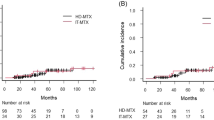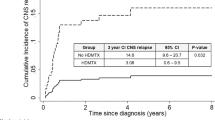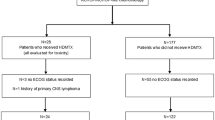Abstract
Central nervous system (CNS) relapse of diffuse large B-cell lymphoma (DLBCL) is a rare but devastating event. Intravenous high-dose methotrexate (HD-MTX) is recommended as CNS prophylaxis, but the optimal timing and dose has not been elucidated. Here, we report a multicenter analysis of prophylactic HD-MTX administration for DLBCL. Two hundred eighty-four patients receiving HD-MTX either concurrent with each induction chemotherapy cycle (n = 221) or at the end of induction therapy (EOI, n = 63) were included. Patients with CNS-IPI scoring 4–6, and/or testicular involvement, and/or double/triple hit lymphoma, were stratified into the high-risk group and the others into the moderate-risk group. Concurrent HD-MTX was associated with increased risk of grade 3/4 treatment-related toxicity (OR,1.49; P = 0.006) and subsequent chemotherapy delays (OR, 1.87; P = 0.003) in multivariate analysis. With a median follow-up of 36.0 months, no significant difference in CNS relapse rate was identified between the concurrent and EOI groups (3.2% vs 4.8%, P = 0.34), even in the high-risk group. Analysis on systemic MTX dose suggested that high-dose MTX (≥ 2 g/m2) was associated with better CNS relapse control only in the high-risk group, but not in the moderate-risk group. This study may elucidate the superiority of EOI HD-MTX to some extent. High MTX dose (≥ 2 g/m2) may not be necessary for the moderate-risk patients.



Similar content being viewed by others
Availability of data and material
The datasets used and/or analyzed during the current study are available from the corresponding author on reasonable request.
Code availability
Not applicable.
References
Al-Hamadani M, Habermann TM, Cerhan JR, Macon WR, Maurer MJ, Go RS (2015) Non-Hodgkin lymphoma subtype distribution, geodemographic patterns, and survival in the US: a longitudinal analysis of the National Cancer Data Base from 1998 to 2011. Am J Hematol 90(9):790–795
Coiffier B, Lepage E, Briere J, Herbrecht R, Tilly H, Bouabdallah R et al (2002) CHOP chemotherapy plus rituximab compared with CHOP alone in elderly patients with diffuse large-B-cell lymphoma. N Engl J Med 346(4):235–242
Pfreundschuh M, Kuhnt E, Trümper L, Osterborg A, Trneny M, Shepherd L et al (2011) CHOP-like chemotherapy with or without rituximab in young patients with good-prognosis diffuse large-B-cell lymphoma: 6-year results of an open-label randomised study of the MabThera International Trial (MInT) Group. Lancet Oncol 12(11):1013–1022
Habermann TM, Weller EA, Morrison VA, Gascoyne RD, Cassileth PA, Cohn JB et al (2006) Rituximab-CHOP versus CHOP alone or with maintenance rituximab in older patients with diffuse large B-cell lymphoma. J Clin Oncol 24(19):3121–3127
Sehn LH, Donaldson J, Chhanabhai M, Fitzgerald C, Gill K, Klasa R et al (2005) Introduction of combined CHOP plus rituximab therapy dramatically improved outcome of diffuse large B-cell lymphoma in British Columbia. J Clin Oncol 23(22):5027–5033
Kridel R, Dietrich PY (2011) Prevention of CNS relapse in diffuse large B-cell lymphoma. Lancet Oncol 12(13):1258–1266
Schmitz N, Zeynalova S, Nickelsen M, Kansara R, Villa D, Sehn LH et al (2016) CNS International prognostic index: a risk model for CNS relapse in patients with diffuse large B-cell lymphoma treated with R-CHOP. J Clin Oncol 34(26):3150–3156
Kridel R, Telio D, Villa D, Sehn LH, Gerrie AS, Shenkier T et al (2017) Diffuse large B-cell lymphoma with testicular involvement: outcome and risk of CNS relapse in the rituximab era. Br J Haematol 176(2):210–221
Zucca E, Conconi A, Mughal TI, Sarris AH, Seymour JF, Vitolo U et al (2003) Patterns of outcome and prognostic factors in primary large-cell lymphoma of the testis in a survey by the International Extranodal Lymphoma Study Group. J Clin Oncol 21(1):20–27
Mazloom A, Fowler N, Medeiros LJ, Iyengar P, Horace P, Dabaja BS (2010) Outcome of patients with diffuse large B-cell lymphoma of the testis by era of treatment: the M. D. Anderson Cancer Center experience. Leuk Lymphoma. 51(7):1217–24
Fonseca R, Habermann TM, Colgan JP, O’Neill BP, White WL, Witzig TE et al (2000) Testicular lymphoma is associated with a high incidence of extranodal recurrence. Cancer 88(1):154–161
Cai QQ, Hu LY, Geng QR, Chen J, Lu ZH, Rao HL et al (2016) New risk factors and new tendency for central nervous system relapse in patients with diffuse large B-cell lymphoma: a retrospective study. Chin J Cancer 35(1):87
Savage KJ, Slack GW, Mottok A, Sehn LH, Villa D, Kansara R et al (2016) Impact of dual expression of MYC and BCL2 by immunohistochemistry on the risk of CNS relapse in DLBCL. Blood 127(18):2182–2188
Oki Y, Noorani M, Lin P, Davis RE, Neelapu SS, Ma L et al (2014) Double hit lymphoma: the MD Anderson Cancer Center clinical experience. Br J Haematol 166(6):891–901
Kanungo A, Medeiros LJ, Abruzzo LV, Lin P (2006) Lymphoid neoplasms associated with concurrent t(14;18) and 8q24/c-MYC translocation generally have a poor prognosis. Mod Pathol 19(1):25–33
Le Gouill S, Talmant P, Touzeau C, Moreau A, Garand R, Juge-Morineau N et al (2007) The clinical presentation and prognosis of diffuse large B-cell lymphoma with t(14;18) and 8q24/c-MYC rearrangement. Haematologica 92(10):1335–1342
Boehme V, Schmitz N, Zeynalova S, Loeffler M, Pfreundschuh M (2009) CNS events in elderly patients with aggressive lymphoma treated with modern chemotherapy (CHOP-14) with or without rituximab: an analysis of patients treated in the RICOVER-60 trial of the German High-Grade Non-Hodgkin Lymphoma Study Group (DSHNHL). Blood 113(17):3896–3902
Gleeson M, Counsell N, Cunningham D, Chadwick N, Lawrie A, Hawkes EA et al (2017) Central nervous system relapse of diffuse large B-cell lymphoma in the rituximab era: results of the UK NCRI R-CHOP-14 versus 21 trial. Ann Oncol 28(10):2511–2516
Kumar A, Vanderplas A, LaCasce AS, Rodriguez MA, Crosby AL, Lepisto E et al (2012) Lack of benefit of central nervous system prophylaxis for diffuse large B-cell lymphoma in the rituximab era: findings from a large national database. Cancer 118(11):2944–2951
Tomita N, Takasaki H, Ishiyama Y, Kishimoto K, Ishibashi D, Koyama S et al (2015) Intrathecal methotrexate prophylaxis and central nervous system relapse in patients with diffuse large B-cell lymphoma following rituximab plus cyclophosphamide, doxorubicin, vincristine and prednisone. Leuk Lymphoma 56(3):725–729
Schmitz N, Zeynalova S, Glass B, Kaiser U, Cavallin-Stahl E, Wolf M et al (2012) CNS disease in younger patients with aggressive B-cell lymphoma: an analysis of patients treated on the Mabthera International Trial and trials of the German High-Grade Non-Hodgkin Lymphoma Study Group. Ann Oncol 23(5):1267–1273
Ferreri AJ, Bruno-Ventre M, Donadoni G, Ponzoni M, Citterio G, Foppoli M et al (2015) Risk-tailored CNS prophylaxis in a mono-institutional series of 200 patients with diffuse large B-cell lymphoma treated in the rituximab era. Br J Haematol 168(5):654–662
Tai WM, Chung J, Tang PL, Koo YX, Hou X, Tay KW et al (2011) Central nervous system (CNS) relapse in diffuse large B cell lymphoma (DLBCL): pre- and post-rituximab. Ann Hematol 90(7):809–818
Abramson JS, Hellmann M, Barnes JA, Hammerman P, Toomey C, Takvorian T et al (2010) Intravenous methotrexate as central nervous system (CNS) prophylaxis is associated with a low risk of CNS recurrence in high-risk patients with diffuse large B-cell lymphoma. Cancer 116(18):4283–4290
Holte H, Leppä S, Björkholm M, Fluge O, Jyrkkiö S, Delabie J et al (2013) Dose-densified chemoimmunotherapy followed by systemic central nervous system prophylaxis for younger high-risk diffuse large B-cell/follicular grade 3 lymphoma patients: results of a phase II Nordic Lymphoma Group study. Ann Oncol 24(5):1385–1392
Cheah CY, Herbert KE, O’Rourke K, Kennedy GA, George A, Fedele PL et al (2014) A multicentre retrospective comparison of central nervous system prophylaxis strategies among patients with high-risk diffuse large B-cell lymphoma. Br J Cancer 111(6):1072–1079
Puckrin R, El Darsa H, Ghosh S, Peters A, Owen C, Stewart D (2021) Ineffectiveness of high-dose methotrexate for prevention of CNS relapse in diffuse large B-cell lymphoma. Am J Hematol 96(7):764–771
Orellana-Noia VM, Reed DR, Sen JM, Barlow C, Malecek MK, Kahl BS et al (2020) CNS prophylaxis during front-line therapy in aggressive non-Hodgkin lymphomas: real-world outcomes and practice patterns from 19 US academic institutions. Blood 136:6
Boehme V, Zeynalova S, Kloess M, Loeffler M, Kaiser U, Pfreundschuh M et al (2007) Incidence and risk factors of central nervous system recurrence in aggressive lymphoma–a survey of 1693 patients treated in protocols of the German High-Grade Non-Hodgkin’s Lymphoma Study Group (DSHNHL). Ann Oncol 18(1):149–157
Hollender A, Kvaloy S, Nome O, Skovlund E, Lote K, Holte H (2002) Central nervous system involvement following diagnosis of non-Hodgkin’s lymphoma: a risk model. Ann Oncol 13(7):1099–1107
Ferreri AJ, Reni M, Pasini F, Calderoni A, Tirelli U, Pivnik A et al (2002) A multicenter study of treatment of primary CNS lymphoma. Neurology 58(10):1513–1520
Ferreri AJ, Reni M, Foppoli M, Martelli M, Pangalis GA, Frezzato M et al (2009) High-dose cytarabine plus high-dose methotrexate versus high-dose methotrexate alone in patients with primary CNS lymphoma: a randomised phase 2 trial. Lancet 374(9700):1512–1520
Magrath I, Adde M, Shad A, Venzon D, Seibel N, Gootenberg J et al (1996) Adults and children with small non-cleaved-cell lymphoma have a similar excellent outcome when treated with the same chemotherapy regimen. J Clin Oncol 14(3):925–934
Rizzieri DA, Johnson JL, Byrd JC, Lozanski G, Blum KA, Powell BL et al (2014) Improved efficacy using rituximab and brief duration, high intensity chemotherapy with filgrastim support for Burkitt or aggressive lymphomas: cancer and Leukemia Group B study 10 002. Br J Haematol 165(1):102–111
Pui CH, Campana D, Pei D, Bowman WP, Sandlund JT, Kaste SC et al (2009) Treating childhood acute lymphoblastic leukemia without cranial irradiation. N Engl J Med 360(26):2730–2741
Durrleman S, Simon R (1989) Flexible regression models with cubic splines. Stat Med 8(5):551–561
Govindarajulu US, Spiegelman D, Thurston SW, Ganguli B, Eisen EA (2007) Comparing smoothing techniques in Cox models for exposure-response relationships. Stat Med 26(20):3735–3752
Wilson MR, Eyre TA, Martinez-Calle N, Ahearne M, Parsons KE, Preston G et al (2020) Timing of high-dose methotrexate CNS prophylaxis in DLBCL: an analysis of toxicity and impact on R-CHOP delivery. Blood Adv 4(15):3586–3593
Funding
This work was supported by grants from the National Natural Science Foundation of China (81973384); the Special Support Program of Sun Yat-sen University Cancer Center (PT19020401), the Science and Technology Planning Project of Guangzhou, China (202002030205), and the Clinical Oncology Foundation of Chinese Society of Clinical Oncology (Y-XD2019-124).
Author information
Authors and Affiliations
Contributions
Y.F. and Q.C. designed the study. Y.F. did the statistical analysis. Y.F., N.S., and S.M. wrote the manuscript. J.C., H.H., Z.L., H.H., Y.X., P.L., L.Z., W.L., L.G., Z.L., Y.W., X.T., J.W., and Y.Z. collected clinical data. All authors read and approved the final manuscript.
Corresponding author
Ethics declarations
Ethics approval
The study was approved by the review board of each participating institution. All the procedures were performed in accordance with the 1964 Declaration of Helsinki principles and its later amendments or comparable ethical standards.
Consent to participate
Patients submitted their written informed consents in accordance with the Declaration of Helsinki.
Consent for publication
The authors provided informed consent to publish.
Conflict of interest
The authors declare no competing interests.
Additional information
Publisher's note
Springer Nature remains neutral with regard to jurisdictional claims in published maps and institutional affiliations.
Supplementary Information
Below is the link to the electronic supplementary material.
Fig. S1 Non-linear relationship between methotraxate dose and survival outcomes in high- and moderate-risk groups
Association of methotraxate dose with progression-free survival (PFS) and overall survival (OS) in high- and moderate-risk group. (A) Unadjusted nonlinear relationship between methotraxate dose and survival outcomes. B, Nonlinear relationship between methotraxate dose and survival outcomes adjusted with age, gender, ECOG PS, LDH, stage and number of extranodal site. Hazard ratios (HR) are indicated by solid lines and 95% confidence intervals (CI) is by shaded areas.
Supplementary file1 (TIF 943 KB)
Rights and permissions
About this article
Cite this article
Fang, Y., Su, N., Ma, S. et al. Optimization of high-dose methotrexate prophylaxis for central nervous system relapse in diffuse large B-cell lymphoma: a multicenter analysis. Ann Hematol 101, 595–605 (2022). https://doi.org/10.1007/s00277-021-04739-x
Received:
Accepted:
Published:
Issue Date:
DOI: https://doi.org/10.1007/s00277-021-04739-x




